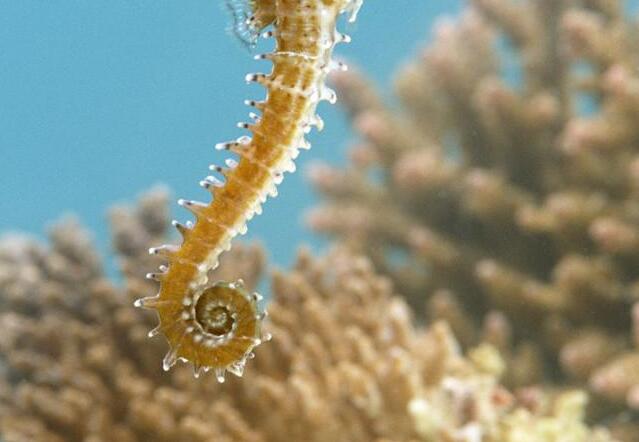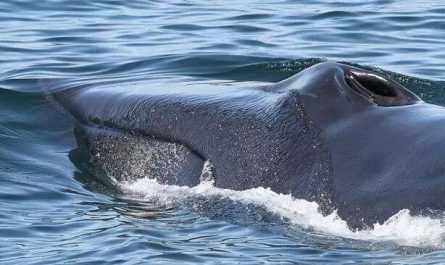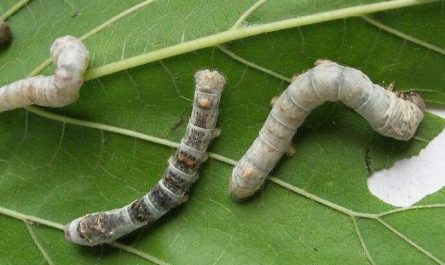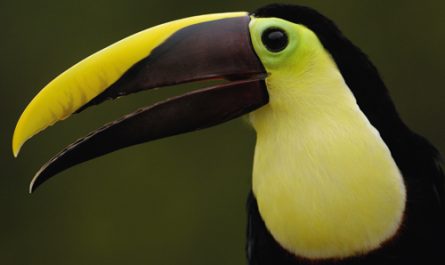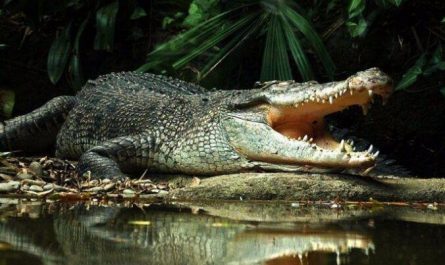The reason why the hippocampus will curl up
The curled tail of the seahorse has a fixed effect. In natural seas, seahorses usually like to live in the slow current of coral reefs. Because they are not good at swimming, they often use their tails suitable for gripping to tightly outline the branches and seaweeds of corals. The body is fixed on the blades of the body so as not to be washed away by the torrent.
The structure and function of the hippocampus tail are quite different from other fish. When the seahorse is resting, the tail can be entangled with the stems and branches of the seaweed by using the curling ability of the tail. Therefore, hippocampus mostly live in areas where deep sea algae flourish. The swimming posture is also very special. The head is up, the body is slightly oblique and stands upright in the water, relying entirely on the dorsal and pectoral fins for movement, and the fan-shaped dorsal fin plays the role of wave propulsion.
The morphological characteristics of the hippocampus
The hippocampus is flat head, with 2 nostrils on each side of the head. The head is bent at almost right angles to the body. The body of the fish is thick and flat on the side, completely encased in the bone ring; the mouth is a pointed tube and the mouth cannot be opened and closed, so it can only suck Small animals in the water are food. The eyes can be turned up and down, left and right or front and back respectively; the chest and abdomen are protruding, the trunk is composed of 10-12 bone rings, and the body length is generally about 15-30 cm; the tail is slender and four Prismatic, fine-pointed tail, capable of curling and gripping, often curled; the head is bent, forming a large obtuse or right angle with the trunk, with a protruding crown on the top and small spines on the crown; the snout is tubular; the mouth is small and the end is The gill hole is small; the whole body is completely covered by the membranous sheet, with a thornless dorsal fin, no pelvic fin and caudal fin. The dorsal fin is located between the trunk and the tail; the anal fin is short; the pectoral fin is well developed; there is no caudal fin; its fins are not easy to see with the naked eye. But with high-speed photography, pay attention to observation, you can see the spines in motion.
These thorns can move back and forth seventy times in one second. According to the wave propagating from the end of the dorsal fin to the other end, the seahorse can ride this wave and move freely back and forth or up and down. The male fish has a childcare sac on the ventral side of the tail, in which the eggs are laid for hatching, and can reproduce 2-3 generations a year. ,
Life habits of the hippocampus
activity
The hippocampus prefers to live in the subtidal sea area where algae clumps or sea leek thrive due to its mimic adaptation characteristics and special habits. Sex is very lazy, often with curled tails entangled on the stems of seaweed, sometimes hanging upside down on floating seaweed or other objects, drifting with the flow. Even if you leave the entanglement temporarily for food or other reasons, after swimming a certain distance, you find other objects attached to it. The swimming posture of the seahorse is very graceful. The fish body stands upright in the water, completely relying on the high-frequency wave-like swings of the dorsal and pectoral fins (10 times per second) and swimming slowly (only 1 to 3 meters per minute). The activities of the hippocampus are generally during the day (morning and afternoon), and at night it is static. When the water quality deteriorates, the seahorse is lacking in oxygen, or is attacked by enemies, it often makes a gurgling sound due to the contraction of the pharyngeal muscles, which sends a “help” signal to the breeder, but it also makes a sound when eating food on the water surface. the difference.
prey
Among fish, the seahorse has a uniquely curved neck, and a long snout head, which looks similar to a horse. The overall shape of the seahorse, coupled with the absence of a tail fin, makes them the slowest swimmers on the planet. They don’t swim fast, they usually just like seaweed, tied to the bottom of the sea with a curly tail.
Because all marine creatures like to eat copepods, they are extremely sensitive to water ripples caused by the approach of predators. Once a copepod detects the approach of an enemy, it can swim more than 500 times its length per second. In contrast, the cheetahs, which are known for their fast running speeds, travel at only 30 times their length per second.
But the seahorse. The hippocampus must use the bow-shaped neck as a spring to twist the head forward to catch prey, which also limits their effective distance to catch food, which is only equal to the length of the neck, which is 0.1 cm. However, the seahorse can use the special shape of the head to quietly approach the prey, and then capture it, and the success rate exceeds 90%. The seahorse’s mouth is located at the end of the long snout. When moving towards the prey, the water patterns around the snout hardly move, so it can sneak close to the other side and successfully prey.
feeding habits
The hippocampus eats food by the extension of the operculum and the snout, and the size of the bait should not exceed the snout diameter. There is a certain degree of selectivity for the type and freshness of bait. The hippocampus’ foraging visual distance is only about 1 meter, so the bait should be cast in frequent clusters. The hippocampus in the natural sea area mainly feeds on small crustaceans, mainly coippods, barnacle larvae of cirrus, larvae and adults of shrimps, firefly shrimp, mysid shrimp and hook shrimp. Under artificial feeding conditions, the effect of feeding mysid shrimp and cherry shrimp is the best, followed by pods and amphipods. Freshwater cladocerans can also be food, but care must be taken to avoid polluting water quality due to rapid death in seawater.
The food intake of hippocampus is closely related to water temperature and water quality. In the suitable temperature range, the water temperature is high, the food intake is large, and the digestion is fast. When the water quality is poor, the food intake is reduced or even stopped. Under normal conditions, the daily food intake of the hippocampus accounts for about 10% of the body weight. The hippocampus has a large food intake at a time, and it is also very resistant to hunger. The hungry tolerance time from primary seedlings to adult fish can reach 4 to 132 days.
Exercise
The structure and function of the hippocampus tail are quite different from other fish. When the seahorse is resting, the tail can be entangled with the stems and branches of the seaweed by using the curling ability of the tail. Therefore, hippocampus mostly live in areas where deep sea algae flourish. The swimming posture is also very special, with the head up and the body upright in the water slightly obliquely, relying entirely on the dorsal and pectoral fins for movement, and the fan-shaped dorsal fin plays the role of wave propulsion.
